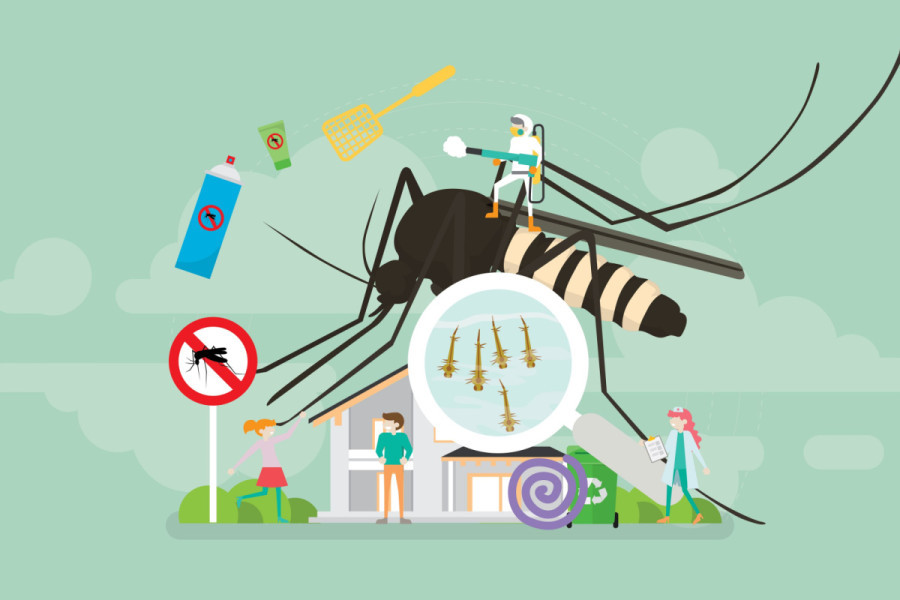Columns
Mild dengue in Kathmandu
A different serotype infection can cause severe symptoms but the same serotype gives lifelong immunity.
Dr Sher Bahadur Pun
There has been a rise in dengue cases in Nepal in recent days. As per the Epidemiology and Disease Control Division (EDCD), 27,968 people have tested positive for the dengue virus, and 15 deaths have been reported from its complications as of September 17, 2023.
A 31-year-old man with mild fever, headache and body aches for five days visited Shukraraj Tropical and Infectious Disease Hospital, Teku, for diagnosis a few days ago. Upon doing a serological test, which detects antibodies in the blood, the patient had a positive immunoglobulin (IgG) antibody for dengue. Common causes of febrile illnesses such as scrub typhus, typhoid fever, brucella and leptospirosis were excluded, and other laboratory results were insignificant. That the patient was diagnosed with the dengue virus despite mild symptoms surprised him. However, it was found that during the 2022 dengue outbreak, he had experienced high-grade fever, severe joint pain, extreme pain behind the eyes, sharp pain at the back of the lower legs (similar to a calf injury), severe lower back pain, loss of appetite and vomiting.
Most patients who tested positive for dengue virus this year in Kathmandu were found positive for IgG serology (NS1 and IgM negative) and experienced mild symptoms compared to the previous year. A recent secondary dengue infection (having dengue fever in the past) is defined by the presence of specific anti-IgG and the absence of anti-IgM antibodies in the early phase of the illness.
Dengue virus has four serotypes: DEN-1, DEN-2, DEN-3 and DEN-4. Nepal saw its first dengue case in 2004; since 2006, all four serotypes have been identified. Unfortunately, the concerned authorities don’t routinely identify serotype(s), blurring the driving force behind the previous outbreaks. In 2006, DEN-1 and DEN-3 serotypes were first reported in Kathmandu. DEN-2 serotype was found responsible for the 2019 outbreak in Kathmandu, while DEN-1 and DEN-3 were found to be the main serotypes responsible for the deadly outbreak in 2022. While subsequent infection with a different serotype can lead to severe dengue, the same serotype provides lifelong immunity. However, repeated infections with the same serotype after a long interval can lead to severe dengue disease, as seen in the reappearance of DEN-1 and DEN-3 serotypes after a 16-year break in Kathmandu (the gap between 2006 and 2022). The 2022 dengue outbreak is Nepal’s biggest and most fatal outbreak.
Reports show that the DEN-2 serotype is primarily responsible for the dengue outbreak in Dharan and is spreading throughout Nepal. A 2019 study revealed that DEN-2 is Nepal’s leading serotype for dengue outbreaks, and 17,992 dengue cases, including six deaths (0.03 percent), were reported in the same year. The episode started in Dharan and spread to other parts of the country, including Kathmandu. I had observed almost all dengue patients with classical dengue fever, meaning only a few patients experienced severe symptoms during their illnesses. DEN-2 serotype is repeating in the current outbreak in Dharan in a four-year interval. However, the fatality rate is lower than the outbreak in Kathmandu last year (after a 16-year interval). This indicates that the same serotype in a given place in a short interval may result in less severe symptoms. Nevertheless, shorter versus longer time intervals of the same serotype and their relationship with disease severity in a given area might interest the scientific community.
Studies have demonstrated that the dengue virus can pass between generations of mosquitoes (Aedes aegypti and Aedes albopictus), known as transovarial transmission. Vertical transmission occurs once a mosquito is infected with the virus, resulting in an infected adult mosquito and maintaining the virus in nature. However, research has yet to fully explain shifting serotype(s) in mosquitoes, as we witness large outbreaks that usually occur at an interval of two to three years in specific areas but with different serotypes. A person obtains lifelong immunity to the serotype that infects them. There will be no large outbreaks if an indigenous mosquito continues to be infected with the same serotype through transovarial transmission. It is unclear whether mosquitoes can be infected with another serotype in a subsequent generation or whether indigenous mosquitoes must be entirely displaced by imported mosquitoes with a different serotype to trigger new significant outbreaks. This can be a subject of debate or interest in the scientific community.
Although the eastern parts of Nepal have observed severe dengue, the proportion of deaths among patients is significantly lower compared to last year’s outbreak in Kathmandu. Moreover, the majority of the patients in Kathmandu who were re-infected with the dengue virus have shown less severe symptoms compared to last year’s Kathmandu outbreak, which could be due to the continuation of transovarial transmission with the same serotype or re-infection with the same or even possibly with another serotype in a short time interval. The reason behind the overwhelming mild dengue in Kathmandu is not apparent; however, this observation could be significant to the scientific community.




 19.12°C Kathmandu
19.12°C Kathmandu















